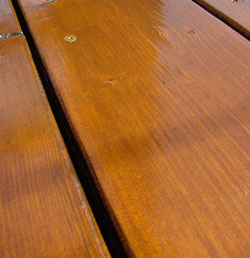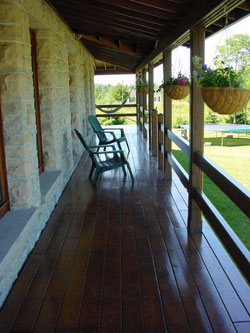 Building and finishing a deck is a lot like marriage. If you’re disappointed by the realities of the arrangement you’ve signed up for, you’ll find it messy, painful and expensive to change course in mid stream. That’s why I want to explain something upfront for those of you planning a new deck, and offer counseling for those trapped in a bad deck relationship.
Building and finishing a deck is a lot like marriage. If you’re disappointed by the realities of the arrangement you’ve signed up for, you’ll find it messy, painful and expensive to change course in mid stream. That’s why I want to explain something upfront for those of you planning a new deck, and offer counseling for those trapped in a bad deck relationship.
The first thing to understand is that keeping any kind of outdoor wood finished isn’t easy. Even the best deck stains require reapplication at least every 24 to 48 months. Most products don’t even last this long. And to make matters worse, no one ever tells you about this ongoing workload as you’re planning to build a wooden deck. In fact, walking down the deck stain aisle of any hardware store would lead you to believe quite the opposite. According to all those cheery labels, decks are obviously easy to finish and a breeze to keep looking beautiful, right? Why else would every can on the shelf claim to offer this happy result?
By contrast, let me tell you about a common plea for help I’ve been getting by e-mail from homeowners across Canada for the last 4 years. The story is always the same: “I bought well-known brand X deck stain, applied it according to the label and within a year the stuff was peeling off in sheets. I went back to the store (very well-known home improvement retailer Y) and they gave me three replacement cans of a new and improved version of brand X. I stripped the deck, applied the new stain and the whole thing is peeling again. The only thing worse than this mess is the way I feel right now. What have I done wrong?”
 The short answer is nothing, except perhaps choosing the wrong stain. Many deck finishes simply don’t work well, even if applied correctly. Success depends on choosing a product with a proven track record, and applying it properly after a preparation process that opens up pores of the wood for maximum absorption. I’ve had excellent personal experience with Sikkens and Cabot products. I’ve also found that a combined approach of pressure washing and sanding works best for preparation, both on new decks and old ones.
The short answer is nothing, except perhaps choosing the wrong stain. Many deck finishes simply don’t work well, even if applied correctly. Success depends on choosing a product with a proven track record, and applying it properly after a preparation process that opens up pores of the wood for maximum absorption. I’ve had excellent personal experience with Sikkens and Cabot products. I’ve also found that a combined approach of pressure washing and sanding works best for preparation, both on new decks and old ones.
Are you planning to build a new deck? Every year I hear from dozens of homeowners who can’t wait for their existing wooden decks to rot so they can file for deck divorce, tear the thing down, then rebuild with some kind of composite or plastic materials. These homeowners would probably recommend you look hard at synthetics up front, before committing to wood. While it’s true that well finished natural lumber looks terrific, you should seriously consider some kind of low maintenance option unless you’re okay with the reality of getting down on your hands and knees to refinish wood every few years.
There are three basic options to consider when it comes to non-wood deck materials:
- Solid composites (most are made from a 50/50 blend of post-consumer reclaimed wood fiber and recycled plastic)
- Hollow composite extrusions (lighter and cheaper than solid composites)
- And a new and growing range of 100% plastic deck boards
 At the moment, none of these choices are suitable for the structural framework of a deck. For this you still need to use wood, though it doesn’t matter much because finishing isn’t an issue when it comes to beams, joists and support posts. For free, detailed information on durable deck design, go to “Building a Top-Notch Deck.”
At the moment, none of these choices are suitable for the structural framework of a deck. For this you still need to use wood, though it doesn’t matter much because finishing isn’t an issue when it comes to beams, joists and support posts. For free, detailed information on durable deck design, go to “Building a Top-Notch Deck.”
One of life’s hidden realities is that it’s almost always easier to acquire things for our homes than it is to maintain them properly. And this is especially true when it comes to something as large as a deck, gazebo, porch, garden arbor or major backyard structure. The key to long-term satisfaction is choosing a design and finishing strategy that limits your ongoing maintenance liability to a level that you can happily handle after the initial enthusiasm of the honeymoon has worn off.



